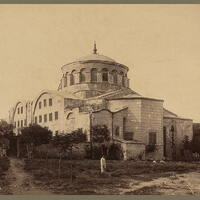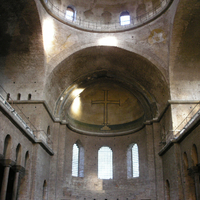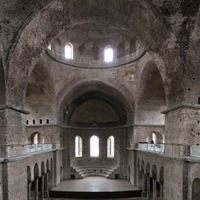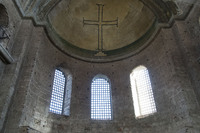Hagia Eirene in Constantinople
Date:
original building ca. 330,
destroyed and rebuilt after 532,
rebuilt after earthquake ca. 800
Location or Findspot (Modern-Day Country):
Turkey
Description:
Hagia Eirene (Holy Peace) was the original cathedral of Constantinople, commissioned by Constantine about 330; Hagia Sophia replaced it as the city's cathedral in 360. It was destroyed in the same urban riot in 532 that occasioned the rebuilding of the adjacent Hagia Sophia, and like that church, it was rebuilt by Emperor Justinian (r. 527–65) as a domed brick basilica with a gallery, preceded by a narthex and atrium. Its 16-meter dome—50 Byzantine feet—is half the diameter of Hagia Sophia's. Also like Hagia Sophia, the north and south sides of Hagia Eirene lacked sufficient buttressing, and the church partly collapsed in an eighth-century earthquake. It was rebuilt in the ninth century (dendrochronology indicates a date after 799) with better support, in the form of transverse barrel vaults. The rebuilt church reused some Justinianic components, including capitals bearing his monogram. It also replicated the sixth-century synthronon in the apse, a semicircular tier of benches for the clergy with a passageway underneath. Above it, the apse conch was decorated with a mosaic cross on steps set against a gold background, a nonfigural scheme that accords with iconoclastic tendencies in the first half of the ninth century. The rest of the church has been stripped of its marble revetment.
Relevant Textbook Chapter(s):
2,
3,
4,
5
Image Credits:
Wikimedia Commons





